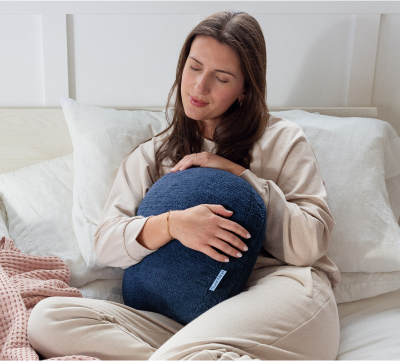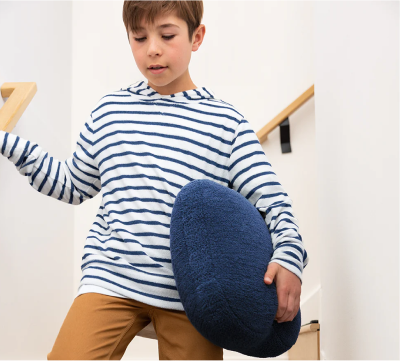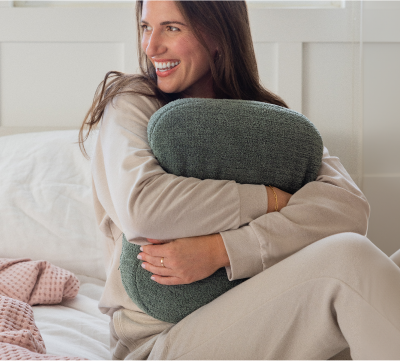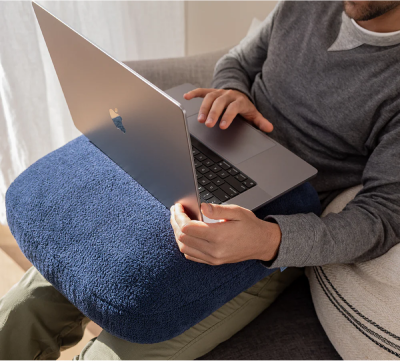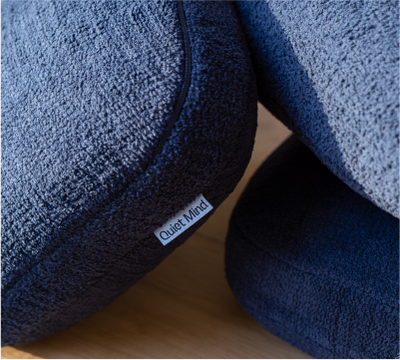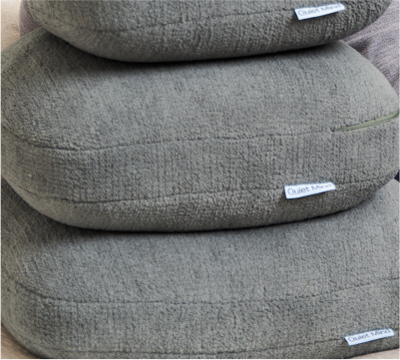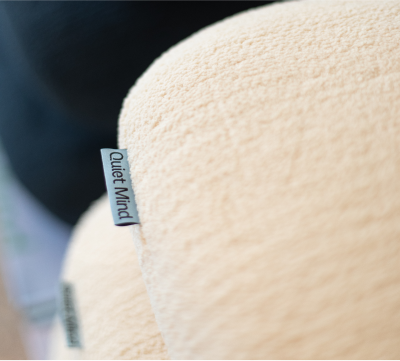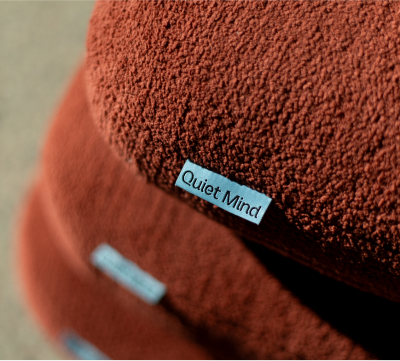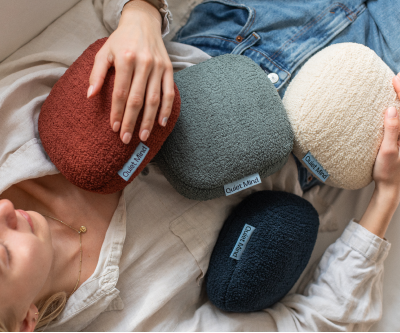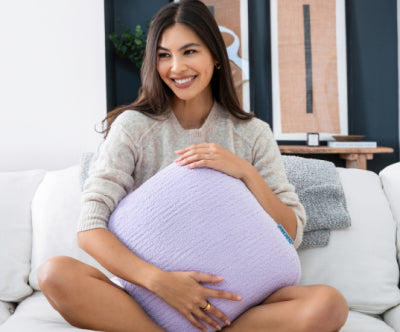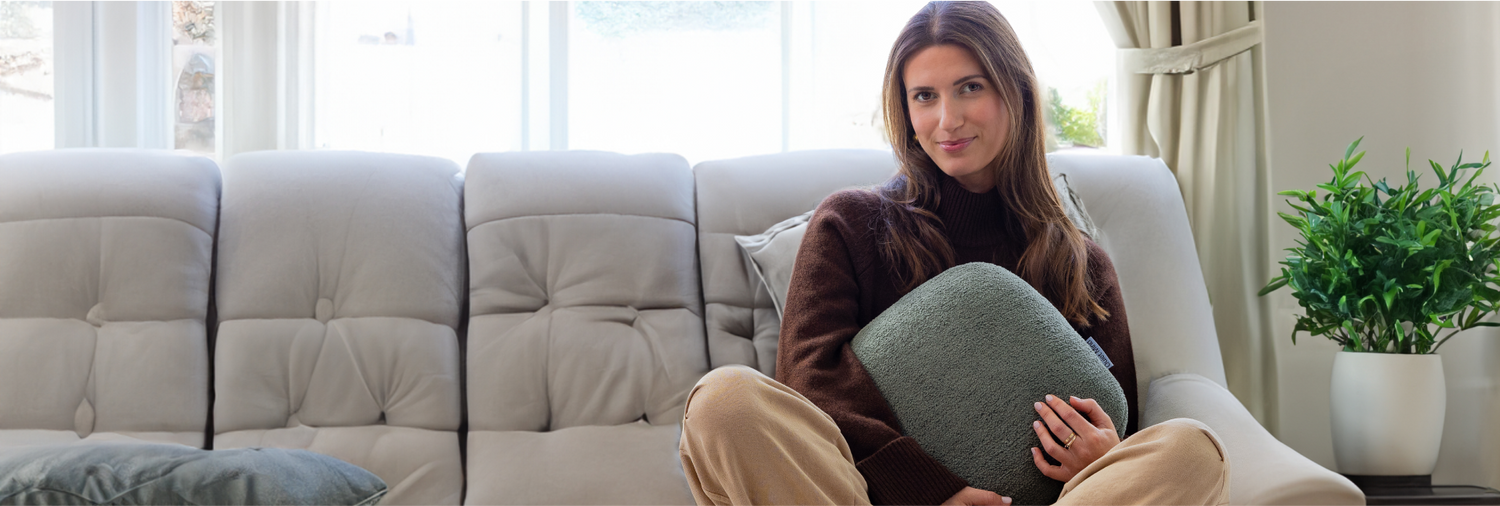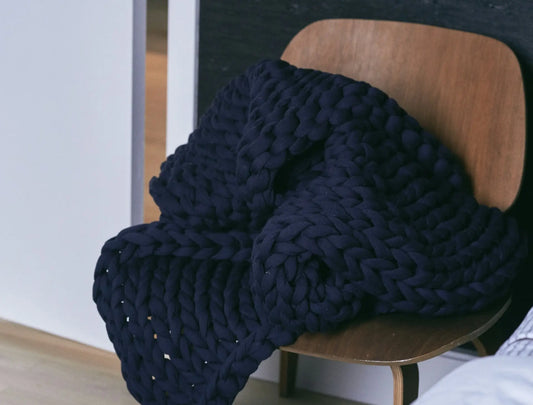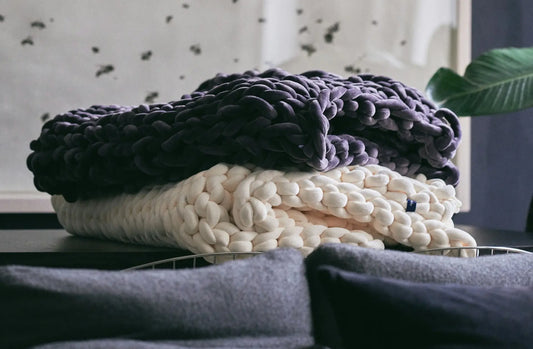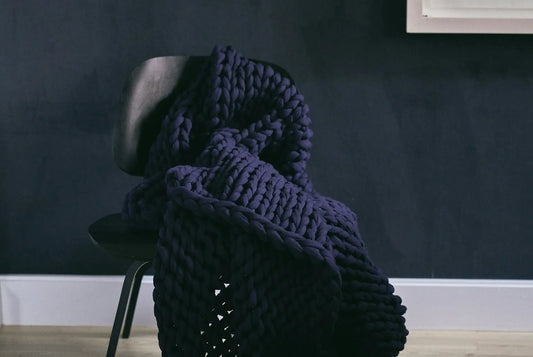Weighted blankets do more than keep you warm, they offer a steady, soothing pressure that many people describe as instantly calming. Whether you're dealing with a racing mind, restless body, or sensory overload, the weight can feel like a quiet anchor. But what’s really happening beneath the surface?
This article gently unpacks the science and sensation behind weighted blankets, from how they interact with your nervous system to why they help some people feel more present, safe, and settled.
Understanding How Weighted Blankets Work
Weighted blankets are more than just cozy. They’re carefully crafted therapeutic tools designed to help people feel grounded, secure, and calm. These blankets apply gentle, even pressure across the body, creating a sensation similar to a firm hug or a comforting embrace. For those dealing with stress, sensory overwhelm, or restless nights, that pressure can feel like a deep exhale after holding tension for too long.
What is Deep Pressure Stimulation (DPS)?
Deep Pressure Stimulation (or DPS) is the core principle behind weighted blankets. It’s a technique used to apply steady, gentle pressure to the body. This pressure sends signals to the brain that it’s safe to relax, something Quiet Mind’s pillow delivers through a blend of glass bead weight and soft foam cushioning, designed to support deep pressure without overwhelming the senses. It helps reduce cortisol (the stress hormone) and encourages the release of calming chemicals like serotonin and dopamine.
For many people, DPS feels like someone placing a calming hand on their shoulder: subtle, but powerfully reassuring. Weighted blankets deliver it across the whole body, while Quiet Mind’s weighted pillow provides the same effect in a lighter, more targeted way.
Proprioceptive Input and Body Awareness
Weighted blankets also engage something called proprioception, which is your body’s sense of where it is in space. When you’re overstimulated, anxious, or distracted, that sense can become blurred, leading to fidgeting, restlessness, or even emotional dysregulation.
The gentle pressure of a weighted blanket provides proprioceptive input that can restore a sense of body awareness. Weighted pillows can do the same but without the bulk, making them easier to use at a desk, during reading, or while traveling.
Pressure Therapy and the Parasympathetic Nervous System
This pressure also taps into the parasympathetic nervous system, often called the “rest and digest” system. When activated, it helps the body slow down, lower the heart rate, and shift out of fight-or-flight mode. That’s why people often describe using a weighted blanket as feeling like flipping a switch, from tense and wired to peaceful and grounded.
Physical and Mental Benefits of Weighted Blankets
Weighted blankets are not just for comfort. Their effects are often noticeable in how people sleep, feel, and manage their days. Whether you’re struggling to wind down at night or need help coping with a racing mind, the benefits can be both immediate and lasting.
Calming the Nervous System
One of the primary reasons people turn to weighted blankets is for their calming effect. By mimicking the sensation of firm, soothing pressure, they help regulate the autonomic nervous system, reducing hyperarousal and overstimulation.
This can be especially valuable for individuals with ADHD, anxiety, or sensory sensitivities, who may feel constantly "on edge" or overstimulated.
Improving Sleep Patterns and Sleep Quality
Many users report falling asleep faster, waking up less often, and feeling more rested after using a weighted blanket. That’s no coincidence. The pressure stimulation helps signal the body to produce melatonin, the hormone responsible for sleep. It also reduces physical restlessness, making it easier to settle in and stay asleep.
Key Benefits for Sleep:
-
Decreases nighttime movement
-
Helps regulate circadian rhythms
-
Promotes deeper stages of sleep
Reducing Anxiety and Stress Responses
When anxiety feels like a buzzing current running through your body, a weighted blanket can offer a physical reset. By lowering cortisol levels and increasing serotonin, it shifts the emotional state from anxious to calm. For people with PTSD or generalized anxiety, this tactile tool can be a gentle way to ease into rest or reduce distress without medication.
Helping with Sensory Processing Disorders
For individuals with sensory processing differences, whether due to autism, trauma, or ADHD, weighted blankets offer predictable and non-invasive sensory input. This type of input is often calming, grounding, and easier to process than unpredictable sounds or touches.
Used thoughtfully, a weighted blanket can be part of a sensory toolkit to reduce meltdowns, improve focus, and create a sense of bodily comfort.
Who Can Benefit from a Weighted Blanket?
Weighted blankets aren’t just for one type of person, they support a wide range of needs, especially those related to sensory regulation, emotional health, and sleep.
Children with ADHD or Autism Spectrum Disorder
Children with ADHD or autism often face challenges with sensory processing, emotional regulation, and overstimulation. A weighted blanket can provide a steady source of calm that helps:
-
Ease transitions (such as bedtime)
-
Reduce restlessness or fidgeting
-
Support body awareness and grounding
These blankets can be especially helpful in creating a bedtime routine that feels predictable and comforting. Weighted pillows can play a similar role but are lighter, easier to move, and more practical for school or homework routines.
Adults with Anxiety, PTSD, or Sleep Disorders
Adults dealing with chronic stress, trauma recovery, or sleep disruptions often find that a weighted blanket becomes a vital part of their nighttime or calming routine. It provides a physical cue that it’s time to slow down, be still, and breathe.
-
For PTSD: It can reduce hypervigilance and nighttime startles
-
For insomnia: It can help settle physical and mental agitation
-
For anxiety: It may help lower heart rate and support a grounded feeling
People Seeking Improved Focus and Reduced Fidgeting
For those who feel distracted, restless, or unsettled, weighted blankets can provide a gentle physical anchor. Some use them while working, reading, or even eating, as a tool to support focus and reduce sensory-seeking behaviors.
Weighted pillows, however, may offer an advantage here, they’re small enough to use at a desk or table without interrupting daily activities.
How Weighted Blankets Help in Daily Life
Weighted blankets aren’t only for bedtime, they can play a meaningful role throughout the day in helping regulate energy, emotion, and focus.
Bedtime Routines and Nighttime Rest
Incorporating a weighted blanket into a wind-down routine can signal to the brain that it’s time to relax. When used regularly, it becomes associated with rest and safety, reinforcing a healthy sleep pattern over time.
Tips for bedtime use:
-
Use during a calming activity like reading or journaling
-
Pair with dim lighting and soft background sounds
-
Layer over a light comforter or sheet for adjustable warmth
Daytime Support for Alertness and Calm
Many people benefit from using a weighted blanket during moments of overwhelm or sensory overload, such as:
-
After school or work transitions
-
During a challenging emotional moment
-
As part of a midday break to reset and regroup
Weighted blankets or pillows can help rebalance energy without needing to leave the room or take medication.
As a Lap Pad for Homework or Meals
Smaller versions of weighted blankets, often called lap pads or weighted pillows, are useful during activities that require stillness. Quiet Mind’s weighted pillow is designed specifically for this kind of flexible, focused use, providing steady pressure that helps regulate energy without overwhelming the senses.
-
Mealtimes for kids who fidget or have sensory sensitivities
-
Homework sessions where focus tends to drift
-
Long car rides or seated waiting periods
By providing consistent pressure, these tools help improve posture, attention, and sensory regulation.
What Are Weighted Blankets Made Of?
The materials inside the weighted blanket and outside it greatly affect its feel, breathability, and sensory experience. Choosing the right combination is key to comfort.
Types of Fillers: Glass Beads, Plastic Pellets, Natural Fillers
|
Filler Type |
Texture |
Pros |
Considerations |
|
Glass Beads |
Fine, smooth |
Even weight distribution, quiet |
Heavier per volume |
|
Plastic Pellets |
Slightly larger |
Budget-friendly, durable |
Can shift more in fabric |
|
Natural Fillers |
(Rice, sand, etc.) |
Eco-friendly, less common |
Not washable, may attract moisture |
Quiet Mind uses recycled glass beads as the filler in its Original Weighted Pillow. These beads are quiet, evenly distributed, and offer a refined feel that’s ideal for people who are sensitive to sound or uneven textures. Combined with a layer of cushioning foam, the beads provide gentle, stable pressure that doesn’t clump or shift.
Some newer designs, such as hand-knit blankets, skip fillers entirely and rely on dense yarn for weight. While minimalist in look, these options don’t offer the same customizable feel or targeted pressure that filled products can provide.
Outer Fabrics and Sensory Preferences
The outer fabric is what you’ll feel most often, so for anyone with sensory sensitivities or texture preferences, it matters just as much as what’s inside.
Common outer fabrics include:
-
Cotton: breathable, soft, and natural-feeling.
-
Minky (plush): velvety and warm, ideal for those seeking a cozy, textured experience.
-
Bamboo or Tencel: cooling, smooth, and moisture-wicking, great for hot sleepers.
-
Polyester: durable, low-friction, and easy to care for, well-suited for everyday use.
Quiet Mind’s pillow is wrapped in a smooth, durable polyester cover that’s intentionally low-friction and gentle against the skin. It’s designed to be both comfortable and practical, easy to clean, resistant to pilling, and supportive of daily sensory use without overwhelming textures.
For people who prefer consistency, minimal stimulation, or who overheat easily, this kind of material offers a grounding experience without added sensory input.
Safety Guidelines for Using Weighted Blankets
While weighted blankets can be incredibly helpful, they aren’t suitable for everyone in every situation. Following safety recommendations ensures they remain a supportive tool, not a risk.
Age and Weight Recommendations
Weighted blankets are not recommended for infants or toddlers. For older children and adults, a general guideline is:
Choose a blanket that is about 10% of the person’s body weight, plus or minus a pound.
Example: A 50-pound child should use a 5–6 lb blanket. A 150-pound adult would typically use a 15–17 lb blanket.
Airway Safety and Supervision for Children
Children should always be able to move freely and uncover their face when using a weighted blanket. Supervise during use until they consistently demonstrate safe and appropriate use, especially if the blanket is used in shared spaces like classrooms or therapy centers.
When to Avoid Weighted Blankets (e.g., breathing issues, poor circulation)
Consult with a healthcare provider before use if you or your child has:
-
Respiratory issues (e.g., sleep apnea, asthma, COPD)
-
Poor circulation or low blood pressure
-
Mobility limitations that prevent removing the blanket independently
Choosing the Right Weighted Blanket for You
A well-chosen weighted blanket should feel like a comforting presence, not a burden. Finding the right one depends on your body, preferences, and environment.
How to Calculate Ideal Blanket Weight (10% Rule)
A simple guideline is to choose a blanket that’s approximately 10% of your body weight, with room to adjust based on your personal comfort level. Some people prefer a slightly lighter or heavier feel depending on their sensitivity to pressure.
|
Body Weight (lbs) |
Recommended Blanket Weight (lbs) |
|
30–50 |
3–5 |
|
51–70 |
5–7 |
|
71–100 |
7–10 |
|
101–120 |
10–12 |
|
121–150 |
12–15 |
|
151–180 |
15–18 |
|
181–200 |
18–20 |
|
201+ |
20–25 |
If you're unsure where to start, choose the lower end of your range, especially if you’re new to weighted products or tend to be sensitive to pressure. Heavier isn’t always better. The goal is comfort, not overwhelm.
Selecting the Right Size, Fabric, and Style
Size: A weighted blanket should cover your body, not the bed. Twin or throw-sized blankets are most common, especially for individual use.
Fabric: Choose a texture that aligns with your sensory needs:
-
Cooling: Bamboo, Tencel
-
Plush: Minky or fleece
-
Natural: Cotton or muslin
-
Smooth & Durable: Polyester (low-friction, easy to clean, suitable for daily use)
Style: Some people prefer quilted blankets with sewn pockets for even weight distribution, while others enjoy knitted weighted blankets that feel more breathable and decorative.
Why Weighted Pillows Are a Better Option
A well-designed weighted product should feel like a comforting presence, not a burden. The right choice supports your body and nervous system without adding strain, fitting naturally into your daily life.
Weighted blankets are ideal for those who enjoy full-body stillness and the feeling of being cocooned. They work best at night, helping reduce tossing and turning while promoting deep relaxation.
Weighted pillows, however, offer a lighter and more adaptable experience. They provide focused pressure where you need it most, such as the chest, lap, or shoulders. Because they are smaller and portable, you can use them anywhere, whether working, reading, meditating, or traveling.
Here’s how weighted blankets and weighted pillows compare across comfort, flexibility, and daily practicality:
|
Feature |
Weighted Blankets |
Weighted Pillows |
|
Pressure Coverage |
Full-body deep pressure stimulation |
Targeted, adjustable pressure for specific areas |
|
Ideal Use |
Nighttime relaxation and sleep |
Anytime use, suitable for daily grounding |
|
Portability |
Bulky and stationary |
Lightweight and easy to carry |
|
Temperature Control |
Can trap body heat |
Naturally cooler and breathable |
|
Ease of Use |
Requires full-body coverage |
Quick to position and remove |
|
Mobility |
Restricts movement once applied |
Allows freedom to move and reposition |
|
Best For |
Deep, steady nighttime calm |
Everyday relaxation, focus, and stress relief |
Quiet Mind Weighted Pillows are designed to offer this flexibility. With evenly distributed glass bead filling and soft, breathable fabrics, they provide consistent pressure that helps your body relax without overheating.
For anyone seeking a calming tool that fits both home and travel routines, Quiet Mind Weighted Pillows deliver the perfect balance of comfort, portability, and peace of mind.
About Quiet Mind
At Quiet Mind, we believe that stress relief doesn’t have to be complicated. Our signature weighted pillows are designed to offer gentle, grounding pressure, like a calming hug for your nervous system.
Whether you’re looking for a more restful sleep or a quiet moment of relief during your day, QuietMind provides tools that support your sensory and emotional well-being, naturally. Discover our weighted pillows and find your path to a quieter mind.
FAQs: What People Commonly Ask About Weighted Blankets
Do weighted blankets really work for anxiety and stress?
Yes, many people report feeling calmer, more grounded, and less anxious after using a weighted blanket. This is largely due to deep pressure stimulation, which helps activate the body’s calming system.
Can children use weighted blankets safely?
Yes, but only with careful weight selection and supervision. They must be able to remove the blanket on their own. Always consult a pediatrician or occupational therapist before introducing one to a child under 8 years old.
Are there side effects of using a weighted blanket?
Most users experience no issues. However, side effects can occur if the blanket is too heavy, used inappropriately, or applied to individuals with breathing or circulatory problems. Always follow usage guidelines.
How do I choose the right weight for my child?
Follow the 10% rule, rounding down to err on the safe side. For example, a 40-pound child should start with a 4-pound blanket. Some brands offer pediatric-specific designs with added safety features.
Can I use a weighted blanket during the day?
Absolutely. Weighted blankets can help with:
-
Regulating energy after school or work
-
Calming during a stressful event
-
Increasing focus while seated
Use a lap-sized version if a full blanket feels too bulky during active hours.
